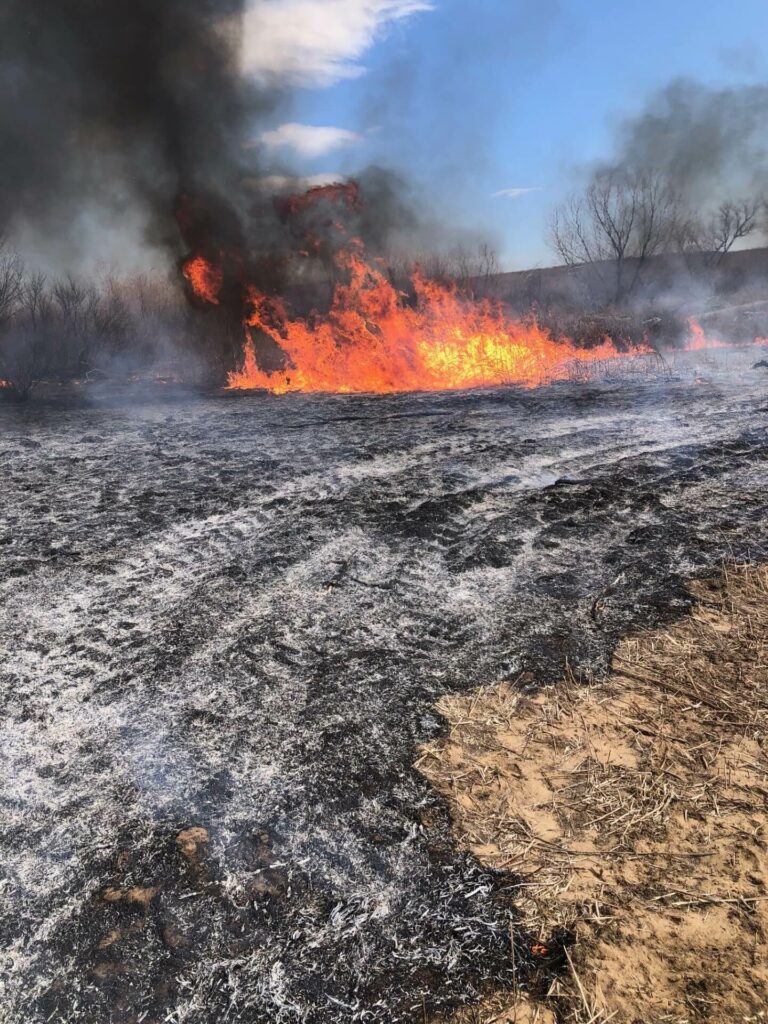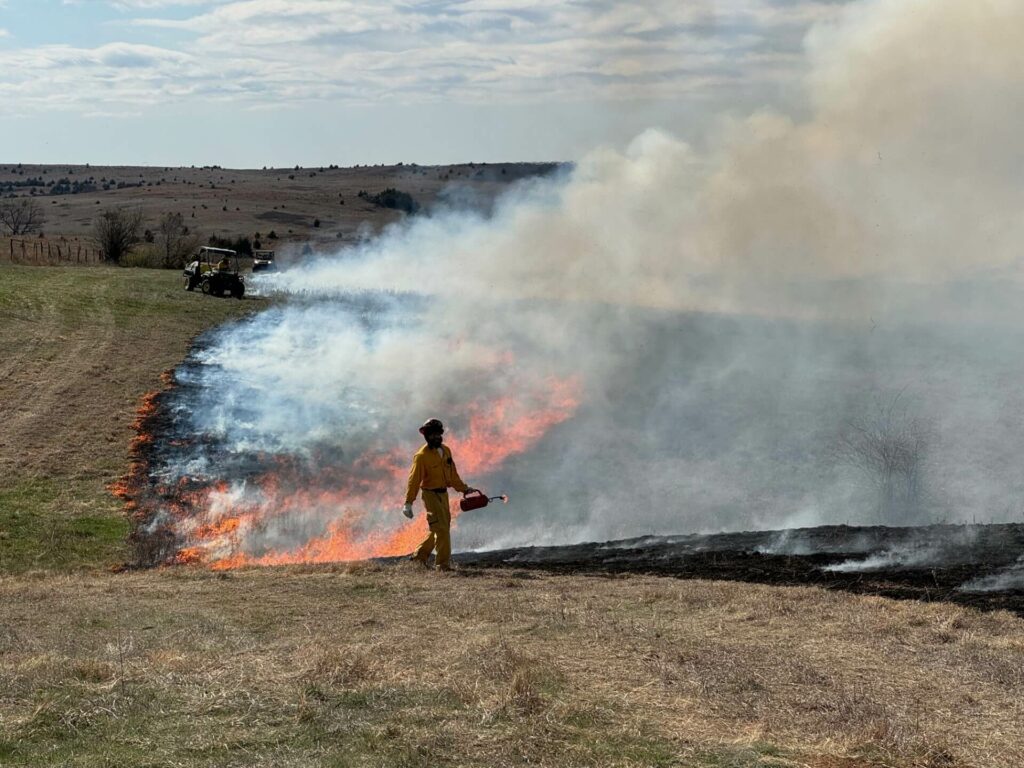Introduction
This past week I started a new job, within the first three days of the job I was gifted the opportunity to help take part in doing a prescribed burn around some private pasture ground and wildlife/hunting areas. Prescribed burning has been a hot topic for the past few decades in regards to use in managing and conserving land and various native ecosystems. Before training and taking part in a prescribed burn, I was under the notion that it was so easy to do prescribed burns and that people were making a big deal about nothing when it came to the overall reluctance to the idea of using it as a conservation tool.
Like many topics revolving around proper land use/management, the talk of or encouragement of prescribed burns tends to be a touchy subject. Many “traditional” farmers and ranchers tend to write off even the idea of burning their land despite documented benefits. Many farmers/ranchers either live on or have too much money tied into machinery, livestock, or infrastructure to risk losing in a fire so the risk of loss ends up out weighing the potential benefits. On the other hand, it seems to be a bit regional in regards to the support of using prescribed burns as a tool.
For those who are not in the conservation/natural resource field, fire may not seem like a logical means to preserve a resource. At first thought, one may associate fire with the common Westernized perspective of fire which is often negative. After years of Smoky the Bear propaganda, it may seem as though we have been lied to. While it is true that fire does have some risk and can destroy buildings/farms and even kill you in the worst situations. The truth is that humans and nature have used fire as a tool across North America for thousands of years to help shape the fertile landscape and natural resources that were available prior to the arrival of European settlers. To withhold fire from a landscape which relies on it is not a good idea.
Besides having a great time helping my coworkers with the burn, I wanted to also help educate anyone who is not familiar with the tool and give out some great information to help change ones mindset or perspective on the matter. I understand that not every piece of land is realistically capable of being burnt, but I do believe that the ones that are able to be burnt should be burnt (in proper conditions). Below I will list five reasons why prescribed burning is important. Most of the reasons revolve around the benefits we can directly see in the modern era and eventually go to list the ecological, more scientific information on the subject.
1. Reduces Fire Potential
If you have been keeping up with the news these past few years, you may have noticed some pretty intense fires happening in Hawaii, California, and other states in the Western portion of the United States. All of these fires were started naturally or unintentionally, but lead to a catastrophic outcome. This happened due to a few core reasons, usually revolving around the presence of invasive plants which create a massive amount of dry fuel, and the presence of copious amounts of fuel built up overtime from the manmade prevention of fire from a landscape. These two factors combined alone could wreak havoc on an area especially when you start factoring in variables such as climate change which promote more unpredictable weather patterns and higher than average temperatures and more frequent observations of drought.
If fire were to be brought back to these landscapes in a more controlled, human based management plan, the entire West would be safer and fewer lives would be affected due to dangerous wildfire. This is because much of the understory brush would be cleared out and a lot of the other areas would be able to possibly reestablish fire loving, native plants, which would help minimize the potential overall risk of fire and also be able to actually minimize or prevent the spread of fire at various points in the year.
Prescribed burns are typically low intensity fires which allows for a more predictable and controllable fire. I like to look at it a regular maintenance on your car, of course you may not need the repair currently, but it is likely down the road that you will run into a bigger issue without the repair.

A Large Brush Fire
2. Puts Nutrients Back in the Soil
Beyond the minimization of fire threat, there are other crucial benefits of fire as well. One of them being the recycling of nutrients often correlated with low intensity fires. The impact of fire on soil was greatly emphasized in a Northern Arizona University article titled, “Fire Effect on Soil” where the author(s) write, “Soil fertility can increase after low intensity fires since fire chemically converts nutrients bound in dead plant tissues and the soil surface to more available forms or the fire indirectly increases mineralization rates through its impacts on soil microorganisms…”. To put in more laymen terms, fire does a fantastic job at breaking down dead plant matter into more accessible forms for other organisms in the soil. It is like a bird bringing its babies part of a worm, or your mom cutting up your food for you when you were a baby.
There are many other instances where fire from prescribed burns seems to actually promote biodiversity in various forms leading to copious amounts of benefits in the long run. The article I cite above does a great job at showing this concept and expressing it into a relatively clear format.
3. Helps Remove Invasive Plants
A major issue of native plants and overall biodiversity are invasive plants. As I mentioned in the first point, invasive plants tend to cause a surplus of fuel for fires and do not do well when burned typically. I do want to point out that this is not always the case for all invasive plants. When participating in the prescribed burn we had at work I was educated on some of the invasive and encroaching plants we were trying to target. These plants included sericea lespedeza (Lespedeza cuneate, a warm season perennial legume used for hay, soil erosion prevention, nitrogen fixation, and wildlife habitat), old world/yellow bluestem or Caucasian bluestem (Bothriochloa ischaemum, used for cattle forage and erosion control), smooth brome (Bromus inermis, used for cattle forage, erosion control and wildlife habitat), and the encroaching Eastern red cedar (Juniperus virginiana, a native tree, but very aggressive/disruptive without fire).
I recall seeing the disappointment on my coworker’s faces when the smooth brome would survive surrounding fires due to it being too green/wet to burn. A day or two prior to the burn I was able to go on a work trip where we visited a small town/rural forestation and listened to professor K C Olson teach us about using fire as a tool to help reduce or remove invasive plants from a location by burning them at different points in their life cycle when they are most vulnerable. In my area it seems that a majority of the burning is done in the early spring to help clear out a lot of the standing fuel from the fall.
The presenter encouraged that people consider burning in the late summer/early fall to help burn plants while they are trying to reproduce and are more vulnerable to fire. Many of their seeds will not survive the burn or fire leading to a reduced number dispersed into the landscape or into the seed bank within the soil. The professor used his own personal experiences and research to justify the benefits of doing prescribed burns in the fall for safer, predictable fires and to remove invasive plants as previously mentioned.
4. Prevents Woody Encroachment

Eastern Red Cedars Burning on a Hillside
With the prevention of fire associated with an increase in invasive grasses and the encroachment of woody plants into our native grasslands. It is important to keep fire as a part of the landscape to help prevent the establishment of woody shrubs and trees across a landscape. Often, once these woody plants are established and over 4 feet tall approximately they are more resilient to fire and will need additional heat to permanently kill the tree.
The topography of an area will also have an impact on the likelihood of a woody growth or cluster to ignite as fire acts more aggressive when moving uphill due to the wind pushing behind it. Jesse B. Nippert, et al., 2021, has a great research article on the topic titled, “Is a Prescribed Fire Sufficient to Slow the Spread of Woody Plants in an Infrequently Burned Grassland? A Case Study in Tallgrass Prairie”. Within the article the researcher’s findings seem to capture the relationship of fire and topography and their impacts on woody encroachment. The research group also seemed to highlight some of the negatives of infrequent use of fire within a prairie ecosystem.
5. Helps Preserve Native Ecosystems
With each passing year we are losing more and more of our remaining prairie remnants. With the loss of native prairie plants follows a natural decrease in observed pollinators and the benefits that follow. Many of these seeds can lay dormant in the soil for many decades, but need proper conditions to be able to make an appearance. Fire along with grazing when properly utilized can do wonders for our grasslands and help promote greater native diversity.
Our native grasslands coevolved with the annual or biannual occurrence of fire. The removal of fire and bison from the plains have since fragmented the ecosystem and reduced the overall function that it once served. It is time to speak up and learn how to bring back or maintain our prairie(s)/grasslands in combination with modern agriculture and landscaping for a more resilient environment in the coming years. The more we learn to use and appreciate fire as a tool, the less we have to fear about more serious wildfires or the need for stronger herbicides to fight against invasive plants.
Conclusion
Prescribed burns are often discussed commonly here in my area and are encouraged. In other parts of the prairie the general perspective is not the same. If we could begin to shift public mindsets on the use of large or small scale burns, we could potentially help revive our grasslands over time. We must think about the generations that have not been born yet and make the proper decisions to help secure what remnants of native biodiversity that we still have and potentially increase it.
I have hope that many will begin to adopt these tools across the world as they begin to see the necessity of it, before it is too late. For as long as I am alive I will be an advocate for prescribed burning. I hope you learned a bit about the subject, and can potentially take part in or observe one as to see the significance first hand to truly grasp the purpose of the event.
Work Cited
Fire Effect on Soil, www2.nau.edu/~gaud/bio300w/frsl.htm#:~:text=Soil%20fertility%20can%20increase%20after,(Schoch%20and%20Binkley%201986). Accessed 30 Mar. 2024.
Nippert, Jesse B, et al. “Is a Prescribed Fire Sufficient to Slow the Spread of Woody …” Is a Prescribed Fire Sufficient to Slow the Spread of Woody Plants in an Infrequently Burned Grassland? A Case Study in Tallgrass Prairie, Science DIrect , 24 May 2021, tradeoffs.oregonstate.edu/sites/agscid7/files/eoarc/attachments/1015_is_a_prescribed_fire_sufficient_to_slow_the_spead_oconnor.pdf.
